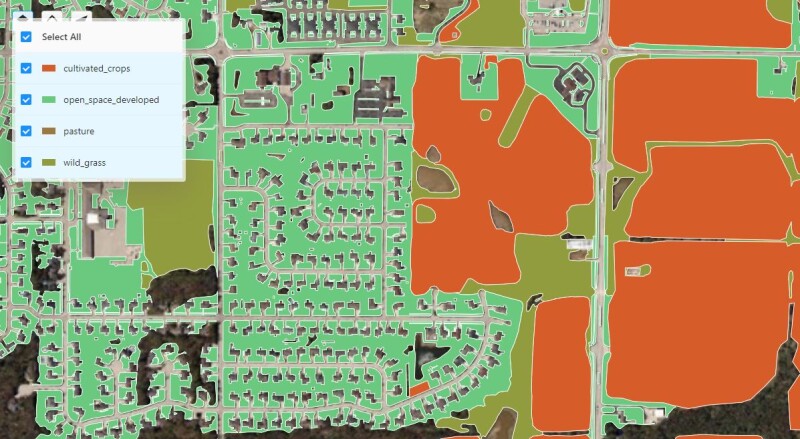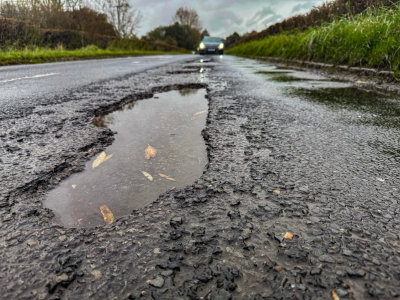July 11, 2024 – Toronto – Today, Ecopia AI (Ecopia) announces the availability of new agricultural land use vector data, bringing a new level of detail to the 3D Nationwide Land Cover dataset. These planimetric vector data layers will enable government agencies to perform more in-depth geospatial analytics related to water usage, tax assessment, land development, runoff calculations, and other detailed analysis workflows.
Launched in 2022, 3D Nationwide Land Cover provides 14 high-precision 2D data layers classifying different land use types, as well as height-attributed (3D) feature classes for buildings, trees, and bridges. These standard data layers, derived from high-resolution geospatial imagery sourced from Ecopia’s global partner network, currently power a variety of mapping and analytics use cases across the United States, including stormwater management, public safety, natural hazard mitigation, and urban/community planning.
With the launch of this additional land use data, organizations will have the choice of further classifying ‘grass’ and ‘agriculture’ features into more specialized layers; Ecopia’s AI-based mapping systems can now classify ‘grass’ as either ‘developed open space’ or ‘wild grass,’ while ‘agriculture’ features can now be differentiated as either ‘pasture’ or ‘cultivated crops.’
Traditional methods for producing planimetric land use data with this level of detail require manual digitization and classification of geospatial imagery. These labor-intensive, expensive processes can take 12+ months to produce data for just one city and are difficult to scale across large areas. As government organizations at the federal, state, and local levels increasingly rely on geospatial data as foundational insight for critical decision-making, manually tracing and classifying individual land use features over entire communities, counties, and states is no longer feasible. This is especially true when considering how quickly land use changes due to rapid urban development, and the subsequent need to keep foundational geospatial information up-to-date with the real world.
Thanks to Ecopia’s innovative AI-based mapping systems, high-precision land use vector data can now be extracted from geospatial imagery in just a matter of weeks. This efficiency enables government agencies to not only develop comprehensive and geometrically accurate land cover databases spanning their entire jurisdictions, but also keep that data up-to-date with a dynamically changing planet to ensure that decisions are made based on real-world conditions, not stale information that could lead to misallocated resources or funding.
The four new planimetric layers produced by Ecopia further align the company’s data offerings to similar environmental datasets produced by the US government, including the USGS’s National Land Cover Database and NOAA’s Coastal Change Analysis Program (C-CAP) data. Earlier this year, Ecopia’s AI-powered mapping systems increased the resolution of C-CAP data by 900x (from 30 meters to 1 meter), providing open access to high-resolution land cover across 1.5M square miles of US coastal communities. This technical alignment with other authoritative datasets commonly used for geospatial analytics also complements recent investments in the USDA’s National Agriculture Imagery Program (NAIP), providing deeper insights for government agencies to leverage in various environmental stewardship initiatives.
“Ecopia is thrilled to launch four new data layers to power unprecedented visibility into land use across the US,” said Brandon Palin, Senior Director of Public Sector and International Development at Ecopia. “Vector data with this level of detail has long been too resource-intensive or expensive for government organizations to produce at scale, and we are proud to leverage our advanced AI-powered systems to provide stakeholders with the geospatial insights needed to make informed decisions related to climate resilience, land use planning, urban development, and more critical initiatives.”
For more information on Ecopia, click here. To view our HD map samples, click here.
About Ecopia AI
Ecopia is on a mission to create a digital twin of the Earth. We leverage artificial intelligence to convert high-resolution imagery into high-definition (HD) vector maps. These maps form a digital representation of reality and are embedded into decision-making applications, offering unique insight at scale. Ecopia’s HD vector maps are leveraged for hundreds of commercial and government applications across over 100 countries around the world.
Source: Ecopia AI






